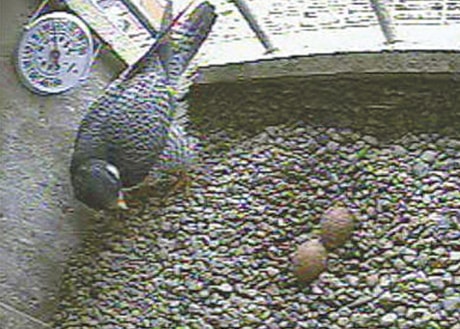There certainly have been a lot of doings going on at the peregrine falcon nest site at the Telus tower this year.
For those of you who aren’t aware, the Red Deer River Naturalists have installed webcams in this nest box and people can view the life of these falcons, up close and personal.
We had one camera in the box last year and the site was wildly popular.
This year we have four cameras. One gives an absolutely superlative view of the outside ledge.
A second one is the night vision camera. Cameras number three and four are stereo views.
We have only one of those stereo views running right now. But these three views are wonderful. If you want to check out the web cam, go to www.rdrn.fanweb.ca and on the home page, click on the peregrine falcons.
The same pair of falcons, Perry (the female) and Windsong (the male) are using the box again this year.
Perry started and finished laying her five eggs on exactly the same date both years: May 1 and May 10.
Last year, on May 30, we had lots of excitement when two of the eggs went missing. There was a lot of speculation about where the eggs had gone.
Everything from ravens to humans were being blamed but whatever had happened, happened at night when we had no views of the box. Hence, the night vision camera this year.
We wanted to be sure to be able to see everything. And just for safety sake, we started recording what was going on in the box.
Lucky thing we did because on May 15, one egg went missing. I downloaded all of the video footage we’d recorded and labouriously went through them all.
From about 10:20 a.m. until 12:45 p.m. I watched the pair of parents breaking up an empty eggshell. Speculations went rampant again. Why were they seemingly eating their own eggs? Did they know that egg wasn’t viable? Just what was going on here?
And then the plot thickened because very quickly two more eggs disappeared.
This time I had quite a few more days of video footage to go through so it took me much longer to find out when it happened.
The second egg was eaten by Perry on May 18 at about 2:15 p.m. The last egg disappeared sometime between 9:45 p.m. on May 18 and 5:30 a.m. on May 19. Whatever they did to this egg was done when their back was to the camera because I could find no evidence of them breaking up the eggshell or committing any other nefarious deed.
Just what was happening? I didn’t have a clue. So I called Dr. Gordon Court, a wildlife biologist with Fish and Wildlife.
He told me that the peregrines definitely do not know whether the eggs are viable or not. The falcons usually incubate their eggs for about 30 days.
He has seen them sit on dud eggs up to 48 days before they finally give up. So what seems to be happening here is that the eggshells are too thin and so they break easily.
This is what went on in the ’60s. The pesticide DDT caused the thinning of the eggs, so few eggs survived to hatch. DDT was banned in Canada in 1969 and in the U.S. in 1972.
But there are other parts of the world where it still isn’t banned.
So Perry could be what is known as a “hot female.” She may have been exposed to pesticides in her southern wintering ground. Another possibility is that this is just her.
Very few peregrines lay five eggs. Perry has laid five eggs three years in a row, that we know of. So perhaps she can’t produce enough calcium for that number of eggs.
Whatever the real reason, we’re all just thankful that two eggs seem to have survived, touch wood.
As one of the chat room people said, “we’re all walking on eggshells till the eggs hatch,” which should be at the beginning of June. Keep your fingers and toes crossed that all goes well. And keep watching.
We have a lot of people to thank for these web cams. One of the people who frequented the chat room last year donated one of the new cameras.
It is taking four computers to run this whole thing. Kerry Wood Nature Centre donated one of the computers and two RDRN Board members donated the other three. Telus have been wonderfully supportive and have put up the box with the cameras in it; as well they have gone up the tower a second time to fix a power problem we were having.
The Red Deer River Naturalists have picked up the tab for the rest of the equipment. And last but not least, we have benefited from the expertise of our technical wizard, who prefers to remain anonymous, but he has done a terrific job putting the whole system together and making sure that everything is up and running.
Judy Boyd is a naturalist with the Red Deer River Naturalists.
